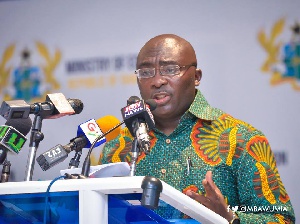 Vice President, Dr Mahamudu Bawumia
Vice President, Dr Mahamudu Bawumia
The Vice President, Dr Mahamudu Bawumia, has underscored the need for greater economic co-operation among Sub-Saharan African countries by developing a common regional market that will exploit the advantages of their natural resources and population.
To that end, he said, there must be a sub-regional strategy to develop the mineral resources such as gold, manganese and iron, in order to move up their global value chain to promote growth and development.
“We need greater co-operation in the management of the natural resources, local content and value addition to mineral resources that will be most beneficial to the sub-region,” Dr Bawumia said.
Vice President Bawumia made the call when he delivered a keynote address at the launch of the 2018 Regional Economic Outlook for the Sub-Saharan Africa in Accra on Tuesday,
He said the sub-region stood to gain by increasing regional inputs to support their manufacturing sectors, which would also attract private sector investments to engender economic growth and job creation opportunities.
He cited, for instance, that Ghana and Guinea could co-operate to develop their bauxite industry since the two countries controlled more than 70 per cent of the world’s bauxite resources for their mutual benefits.
The event organised by the International Monetary Fund (IMF) in collaboration with the Ministry of Finance on the theme: “Domestic Revenue Mobilisation and Private Investment” brought together a delegation from the IMF, Ministers of State, financial and economic experts from the Sub-Saharan Africa and the Diplomatic Community.
The Regional Economic Outlook calls attention on the global economic growth, sluggish growth recovery in the sub-region, the relative higher commodity prices in the region and the need for improved market accessibility.
Highlighting on the theme for the meeting, Vice President Bawumia said it confirmed the Government’s focus on domestic resource mobilisation as one of the key elements towards achieving “Ghana beyond aid”, and not only for Ghana, but for the entire sub-region.
He underlined the need for urgency in mobilising domestic resources through innovative strategies to accelerate economic growth, while taking advantage of the external resource available as well.
“These macroeconomic vulnerabilities and the option to tackle those weaknesses hinged on two key areas: mobilise domestic resources to finance social spending and infrastructural development and the ability to embark on reforms that will stimulate private sector for investment in order to accelerate growth and job creation,” Dr Bawumia said.
According to the African Development Bank latest Economic Outlook, the average economic growth in the sub-region stalled in 2016 with 0.5 per cent, but it recovered in 2017 to 2.5 per cent.
It is, therefore, projected to rise to 3.8 per cent this year and to 3.9 per cent in 2019.
Vice President Bawumia noted that macroeconomic stability in the sub-region remained a challenge with inflationary rate averaging 8.2 per cent in 2014, rose to 13 per cent in 2017, and projected to reduce to about 11 per cent this year and 2019.
Touching on Ghana’s economic growth, the Vice President said, it had witnessed exceptional increase from 3.6 per cent in 2016 to 8.5 per cent at the end of 2017 and expected to grow between six to seven percent in 2018 and 2019.
He said the gains were recorded due to prudent budgetary management by the Government, with tight fiscal control and monetary discipline.
He said there had been a decline in the year-on-year inflation from about 17 per cent in 2016 to 10.4 per cent in the first quarter of 2018, while the supplied side improved driven by the growth in the agricultural sector.
However, he said, the overall economic growth across the sub-region, had not been inclusive to expand job creation opportunities, while unemployment among the youth had been rising with insufficient growth to reduce poverty levels.
“The constraint factors of growth in the sub-region remained largely the same, including the pervasive political and non-tariff trade barriers, poor and uncoordinated energy supply, and infrastructure in roads and railway networks, therefore making it unattractive for investment.
“The expectation that rising manufacturing labour cost in China may present opportunities to West Africa and that of the Sub-Saharan Africa in light manufacturing is yet to be realised,” he added.
To turn around the fortunes of the sub-region, Vice President Bawumia called for infrastructural development in key areas such as energy, transportation, improvement in ports facilities and a predictable business environment.
“The old paradigm of natural resource exploitation and export of unprocessed agricultural products and raw minerals were no longer sufficient to grow the economies of the sub-region to create jobs, meet social expectations and provision of basic social amenities,” he noted.
Therefore, he said, it was crucial to re-examine the natural resource control and governance strategy, resource fiscal regime from exemptions to carried interest and better use the natural resources to build a prosperous economies.
He cited, for instance, that Ghana’s carried interest in mining sector was 10 per cent and expected to receive dividends from mining firms, but since 2012, it showed metrix of zeros as far as dividends were concerned, which implied that mining firms were not making profits.
The Vice President, therefore, queried why the mining firm continued mining while they were not making profits, “It’s very difficult to reconcile that they have been mining for all these years and they’re not making profits,” he said, adding: “It doesn’t make sense and we need to look at it”.
He said Ghana had been taking concrete steps in formalising her economy to broaden the tax base, and cited the National Identification System, the National Property Digital Address System, digitisation of the lands records and paperless ports system, which would help in building a new platform for revenue mobilisation and, thus, urged other countries in the sub-region to emulate it.